Part I | Part II | Part III
Second of three parts
Compiled by Ken George based on the
radio documentary by Michael Goldfarb
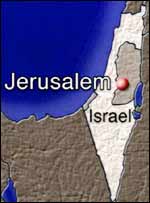 |
(AP)
|
In 1948, at the end of Israel's War of Independence, Jerusalem was divided - with the Old City and Eastern Jerusalem under the control of Jordan. In the Six Day War of 1967 that situation changed.
But uniting a city militarily doesn't mean it is united in other ways. Peace activist Judit Keshet noted this while watching Israeli soldiers turn back elderly Palestinians at a roadblock at the city's edge. "Jerusalem is a divided city today," says Keshet. "It is divided in fact in many ways, between Jews and Arabs, between religious Jews and secular Jews, richer Jews and poorer Jews. It is nonsense to say it can never be divided again."
Sometimes the physical division of Jerusalem is clear: stand on National Road 1, turn west and the city is basically Jewish; turn east and the city is basically Arab. In the Old City you can hardly see the separation because the two divided worlds are actually contiguous: The Wailing Wall forms part of the foundation of the al-Aqsa mosque; the ceiling of an Arab apartment is the floor of a Jewish yeshiva.
 |
Avraham Biran.
(Av Harris)
|
In the abstract, the separation works its way into the history both sides tell. Even dispassionate historians can't agree on the question of when the story of modern Jerusalem begins.
Archaeologist Avram Biran of Hebrew Union College selects 1948, the year Palestine was partitioned, Israel created and the British, who had ruled Palestine by Mandate since the end of the First World War, left without much ado.
"I think if the British had wanted to leave in an orderly fashion, I really believe that you could get the Jews and the Arabs together to agree on some kind of a solution," says Biran. "But they just got up and left. A vacuum was created and as a result of the vacuum came the war."
Now 91, Avram Biran, was the district officer for Jewish Jerusalem during the waning days of the British Mandate. He remembers retrieving deeds so owners could reclaim their lands and houses following the anticipated war.
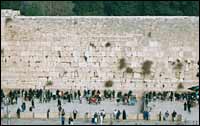 |
The Western or "Wailing" Wall.
(Av Harris) |
Biran claims he was simply carrying on an old tradition in the region. Back in 130 CE, the Jews, led by Simon Bar Kochba, rebelled against Rome. Fifty years ago in a cave in the Judaean Hills, some letters of those people who fled the Romans were found - including some property titles belonging to a woman named Bavta. Biran was struck by the parallels with his own actions in 1948. "The same concern people have for their property, their rights, and what they owned duplicated itself," he says.
Albert Aghazerian, a Palestinian historian, tells the story of Jerusalem differently.
According to Aghazerian, "the history of this city as a living mechanism starts at an important watershed which is 1831." That's the year when the Egyptians invaded," he says.
It was Egypt's conquest of Palestine that expanded the playing field for European imperial games as both Britain and France had strategic interests in propping up the Egyptian regime.
 |
Michael Goldfarb interviews the Grand Mufti of Jerusalem.
(Av Harris) |
Albert Aghazerian's lesson is clear. Europeans came from the West in 1831, and the presence of European powers in the region led to the migration of European Jews to Palestine and to today's conflict.
However, if you start your story in 1948, as Israeli archaeologist Avram Biran does, you come to a different conclusion. "In times of war the victor takes over the possession of the vanquished," he says. That's what the
Jordanians did in the Old City and in the areas which they held, and that is what the Israelites did after 1967."
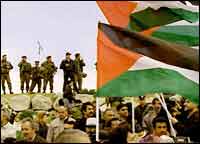
|
| Palestinians with flags protest Israeli construction in East Jerusalem. (AP) |
Of course, both sides are divided on the facts of the city's ancient history. The Mufti, the supreme Islamic cleric of Jerusalem, issued this fatwa: "The Wailing Wall was in no way part of the Jewish Temple and the Jewish claim to it is false." When asked whether he was speaking from a religious or historical perspective he answered through a translator, "The wall was named Burak ... it was not mentioned as The Walling Well except in the past 100 years ... all the stones of Burak are Muslim stones." The archaeological facts are at variance with the Mufti's assessment. They indicate that the stones of the Wailing Wall are from the Roman period. But facts are not a valuable form of currency in Jerusalem.
***
There is much more to Jerusalem than the Old City with its disputed religious sites crammed inside its one square kilometer of walls. The capital of Israel is a modern city of 646,000 strewn across 123 square kilometers of jagged hills and steep, narrow valleys. The hills are scarred by white rock. The hilltops have been crowned by new neighborhoods built for Jews after the 1967 war. The buildings in these neighborhoods are all made of this white stone. The stone gives them a look of inevitability and impregnability. Still, that doesn't mean they aren't targets during the current intifada.
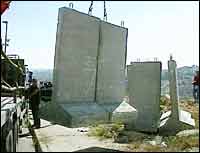 |
| Israeli army engineers erecting barricades in Jerusalem's Gilo neighborhood. (AP) |
This year in Jerusalem gun and tank fire fills the night air at the southern edge of town.
In Gilo, one of the new neighborhoods, snipers from across the steep valley in the Palestinian town of Beit Jala, fire on cars traveling from Jewish settlements in the West Bank and at apartment houses on Ha'anafa Street.
Momi Abulaffia, a Moroccan Jew, lives in a small two-bedroom apartment in Gilo with his wife and two year-old son. They moved in a year and half ago, impressed by the view of the mountains across the way.
He says holes in the walls of his apartment are the result of sniper fire from Beit Jala.
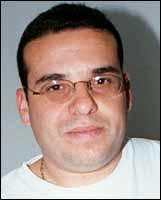 |
| Momi Abulaffia. (Av Harris) |
At his next-door neighbor Yaron Cohen's house, the nightly shooting has provided an excuse for a family gathering. His parents, brother and sister want to show solidarity and also scold Yaron just a little.
"He is a joker, yesterday they were shooting about 7, 7:30, so he called his mom, he took the phone put it in the window, and let his Mom hear the shooting," says David, his father. The family sits around sipping tea and eating sweets; the mood is light. But there is an undercurrent of tension between he father and son who disagree about the best way for the Israeli government to handle the situation. Once they start the shooting, we have to get into Beit Jala, to Bethlehem and put the army over there for good," says Yaron. His father disagrees: "I don't think that's the right solution ... once you occupy the next neighborhood there will be no end to this. The end to this situation is simply peace." He thinks such a peace will come about as a result of the establishment of a Palestinian state.
Across the divide in the united city of Jerusalem, that sentiment is not uncommon. But people also expect that before there is peace - there will be war.
<< Part I |
Part III >>
|
 |






